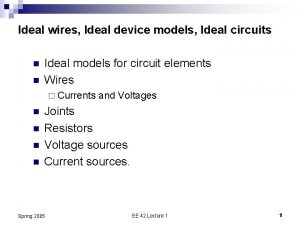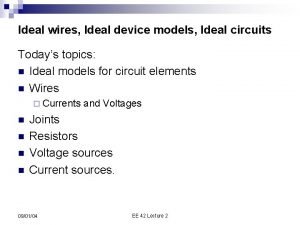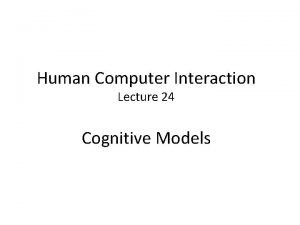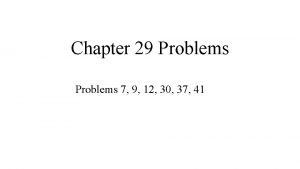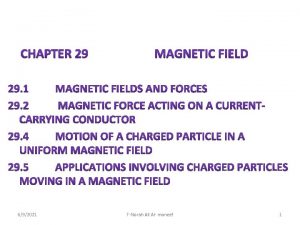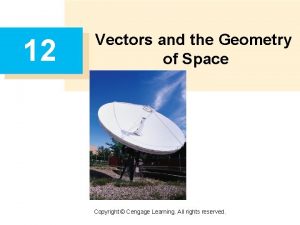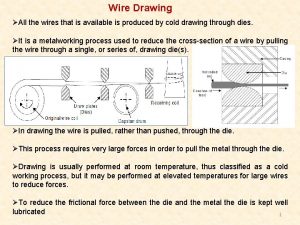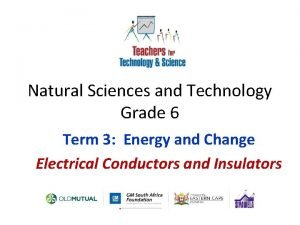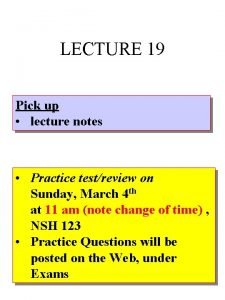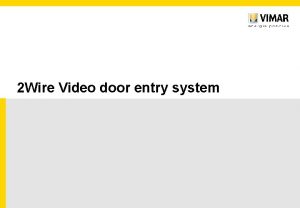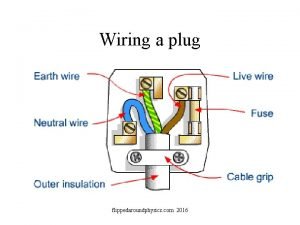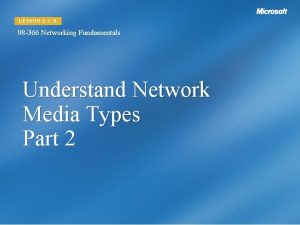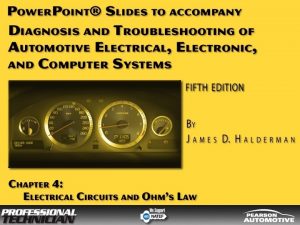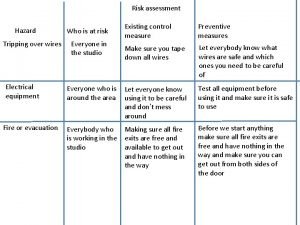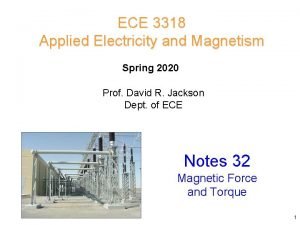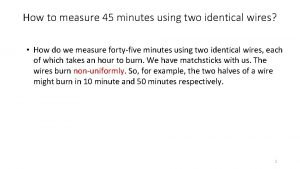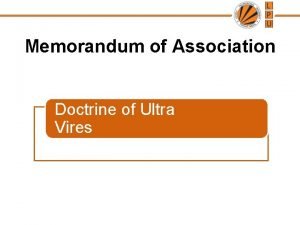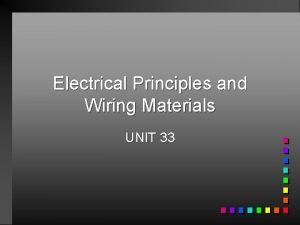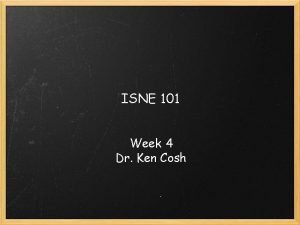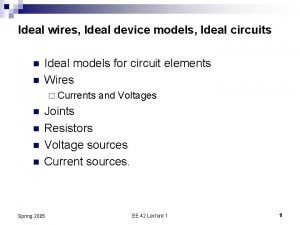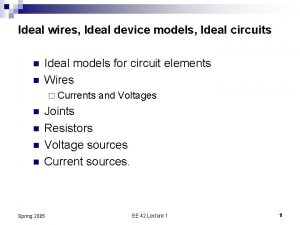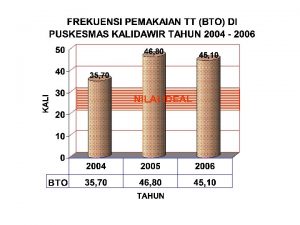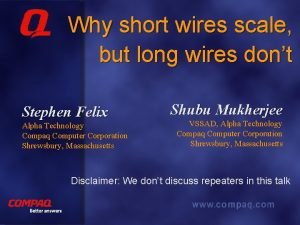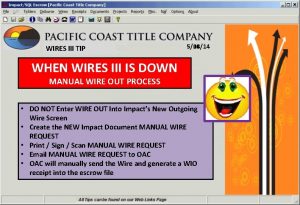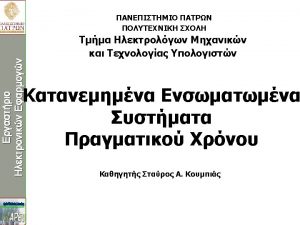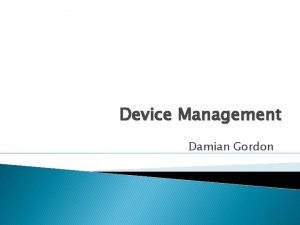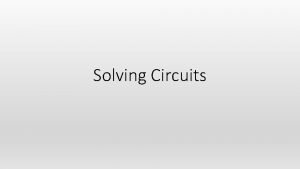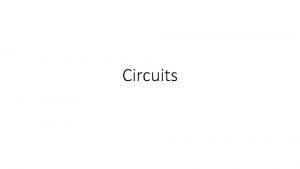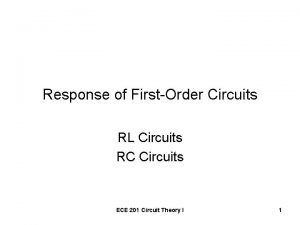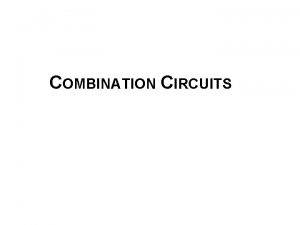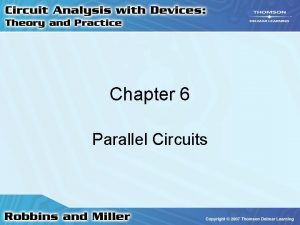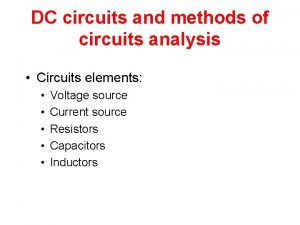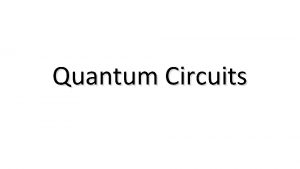Ideal wires Ideal device models Ideal circuits Todays






















- Slides: 22

Ideal wires, Ideal device models, Ideal circuits Today’s topics: n Ideal models for circuit elements n Wires ¨ Currents n n and Voltages Joints Resistors Voltage sources Current sources. 09/01/04 EE 42 Lecture 2

Cast of Characters n Fundamental quantities ¨ ¨ n Fundamental concern ¨ n Charge Current Voltage Power Current-Voltage Relationship Fundamental elements ¨ ¨ ¨ 09/01/04 Resistor Voltage Source Current Source EE 42 Lecture 2

Charge n n n You are already familiar with the idea of charge from chemistry or physics. We say a proton has a positive charge, and an electron has a negative charge. Charge is measured in units called Coulombs, abbreviated C. 1 proton = 1. 6 x 10 -19 C 1 C is a whole lot of protons! 1 electron = -1. 6 x 10 -19 C 6. 25 x 1018 protons in 1 C. 09/01/04 EE 42 Lecture 2

Electric Field n n n We know that opposite charges attract each other, and like charges repel. The presence of a charged particle creates an electric field. Other phenomena also create an electric field. The electric field is a lot like gravity. It can point in different directions and have different strength depending on location. Vector fields are like wind maps from your weather forecast. + Earth 09/01/04 EE 42 Lecture 2

Voltage n n n It takes energy to move a proton against the direction of an electric field (just like it takes energy to lift an object off the ground, against gravity). Suppose it takes (positive) energy to move a proton from point a to point b. Then we say point b is at a higher electric potential than point a. The difference in electric potential between two points is called voltage. Voltage, measured in Volts (V) indicates how much energy it takes to move a charge from point to point. + b a 09/01/04 EE 42 Lecture 2

Voltage Conventions n n Voltage is always measured between two points (just like distance). We need to specify the “start” and “finish”. We could write + saying that b is 5 V higher than a. b a Or, we could write 5 V + saying that a is -5 V + -5 V higher than b. When we put down a + and a – to specify a voltage, it is simply a reference frame. We are not making a statement about which point actually has the higher potential, since the voltage in between can be negative! 09/01/04 EE 42 Lecture 2

Voltage Conventions: Notation n a “Vab” means the potential at “a” minus the potential at “b” (that is, the potential drop from “a” to “b”). b Remember, this is not saying that the potential at “a” is higher than the potential at “b”. The difference could be negative. 09/01/04 EE 42 Lecture 2 VRoss We can make up voltages with any names we wish, as long as we provide a reference frame (+ and -). Here, VRoss is the potential rise from left to right (or, the potential drop from right to left, or the right potential minus the left). | n We can use subscript convention to define a voltage between two labeled points:

Examples The flat end of the battery is at lower potential than the “bump” end. B A C 9 V 1. 5 V What is VAD ? D -1. 5 V + 9 V = 6 V Find V 1 and Vx. B A 1. 5 V 09/01/04 V 1 C D 9 V V 1 = 1. 5 V VX = -6 V + VX + EE 42 Lecture 2

Voltage Conventions: Ground n n n Many times, a common point will be used as the starting (-) point for several voltage measurements. This common point is called common or ground. We may define a voltage at point “a” with respect to ground. This refers to the voltage with + reference at “a” and – reference at ground. Voltages with respect to ground a z are often denoted using a Va single subscript: Notice the symbol for ground. Also seen is Vz n 09/01/04 EE 42 Lecture 2

Current: Moving Charge n n n An electric field (or applied energy) can cause charge to move. The amount of charge per time unit moving past a point is called current. Current is measured in Coulombs per second, which are called Amperes (abbreviated A and called Amps for short). Mathematically speaking, where i is current in A, q is charge in C, and t is time in s Even though it is usually electrons that do the moving, current is defined as the flow of positive charge. 09/01/04 EE 42 Lecture 2

Current Reference Direction n Current also needs a reference frame. To define a current, draw an arrow: 5 A -5 A n This says “the current moving through the device from left to right is 5 A”. We could also say, “the current moving through the device from right to left is -5 A”. Drawing an arrow does not make a statement about the direction the current is actually going. It is just a reference frame. You can draw arrows however you want when you need to solve for currents. n n 09/01/04 EE 42 Lecture 2

Resistance n n Current is due the ability of electrons to break away from atoms and move around. In some materials, like metals, where there are few valence electrons, little energy is needed to break bonds and move an electron. In other materials, a strong electric field (voltage) must be applied to break the bonds. These materials are said to have a higher resistance. Resistance, measured in Ohms (Ω), indicates how much voltage is necessary to create a certain amount of current. 09/01/04 EE 42 Lecture 2

Power n n n Power is the amount of energy absorbed or generated per unit time. It is the time derivative of energy, and it is measured in Watts (W). The power absorbed (or generated) by a device is equal to the product of the current through the device and the voltage over the device: p = v i where p is power in W, v is voltage in V and i is current in A. Sometimes this equation gives you the power absorbed by the device, and sometimes it provides the power generated by the device. 09/01/04 EE 42 Lecture 2

Power: Sign Convention n Whether “p = v i” provides absorbed power or generated power depends on the relationship between the current and voltage directions. If the current i is referenced to flow from the “+” terminal of v to the “-” terminal of v, then “p = v i” provides the power absorbed. When the opposite is true, “p = v i” provides the power generated. Power absorbed by i 1 i 2 device = (Vdevice) (i 1) + 09/01/04 Vdevice - Power generated by device = (Vdevice) (i 2) EE 42 Lecture 2

Power Calculations Find the power absorbed by each element. 2 V + + 0. 5 m. A 09/01/04 + 3 m. A 3 V 1 V + 2. 5 m. A 1 V Element : (3 V)(-3 m. A) = -9 m. W Element : (2 V)(3 m. A) = 6 m. W Element : (1 V)(0. 5 m. A) = 0. 5 m. W Element : (1 V)(2. 5 m. A) = 2. 5 m. W EE 42 Lecture 2

Current-Voltage Relationship n n In this course, we deal with circuits that perform computations, where the numbers are voltages. Voltages appear at the input, and create current in the devices, which in turn changes the output voltage—and computation has taken place. The relationship between current and voltage in a device is fundamental. Circuit elements are characterized by their current-voltage relationships. It is these relationships that allow us to design and analyze circuits. We will now present current-voltage relationships (called i-v relationships for short) for basic circuit elements. 09/01/04 EE 42 Lecture 2

Basic Circuit Elements n Wire (Short Circuit) ¨ Voltage n Resistor ¨ Current n is a given quantity, current is unknown Ideal Current Source ¨ Current n is proportional to voltage (linear) Ideal Voltage Source ¨ Voltage n is zero, current is unknown is a given quantity, voltage is unknown Air (Open Circuit) ¨ Current 09/01/04 is zero, voltage is unknown EE 42 Lecture 2

Wire n n Wire has a very small resistance. For simplicity, we will idealize wire in the following way: the potential at all points on a piece of wire is the same, regardless of the current going through it. ¨ Wire is a 0 V voltage source ¨ Wire is a 0 Ω resistor n This idealization (and others) can lead to contradictions on paper—and smoke in lab. 09/01/04 EE 42 Lecture 2

Resistor n The resistor has a currentvoltage relationship called Ohm’s law: i + R v=i. R where R is the resistance in Ω, i is the current in A, and v is the voltage in V, with reference directions as pictured. v - n If R is given, once you know i, it is easy to find v and vice-versa. n Since R is never negative, a resistor always absorbs power… 09/01/04 EE 42 Lecture 2

Ideal Voltage Source n n The ideal voltage source explicitly defines Vs the voltage between its terminals. ¨ Constant (DC) voltage source: Vs = 5 V ¨ Time-Varying voltage source: Vs = 10 sin(t) V ¨ Examples: batteries, wall outlet, function generator, … The ideal voltage source does not provide any information about the current flowing through it. The current through the voltage source is defined by the rest of the circuit to which the source is attached. Current cannot be determined by the value of the voltage. Do not assume that the current is zero! 09/01/04 EE 42 Lecture 2

Ideal Current Source n n n The ideal current source sets the Is value of the current running through it. ¨ Constant (DC) current source: Is = 2 A ¨ Time-Varying current source: Is = -3 sin(t) A ¨ Examples: few in real life! The ideal current source has known current, but unknown voltage. The voltage across the voltage source is defined by the rest of the circuit to which the source is attached. Voltage cannot be determined by the value of the current. Do not assume that the voltage is zero! 09/01/04 EE 42 Lecture 2

Air n n n Many of us at one time, after walking on a carpet in winter, have touched a piece of metal and seen a blue arc of light. That arc is current going through the air. So is a bolt of lightning during a thunderstorm. However, these events are unusual. Air is usually a good insulator and does not allow current to flow. For simplicity, we will idealize air in the following way: current never flows through air (or a hole in a circuit), regardless of the potential difference (voltage) present. ¨ Air is a 0 A current source ¨ Air is a very big (infinite) resistor There can be nonzero voltage over air or a hole in a circuit! 09/01/04 EE 42 Lecture 2
 Hardware output
Hardware output Current in a parallel circuit
Current in a parallel circuit Ideal wires
Ideal wires Ideal device
Ideal device What is the difference between model and semi modal
What is the difference between model and semi modal Bnf in hci
Bnf in hci A conductor suspended by two flexible wires
A conductor suspended by two flexible wires A conductor suspended by two flexible wires
A conductor suspended by two flexible wires A 100 lb weight hangs from two wires
A 100 lb weight hangs from two wires Progressive dies
Progressive dies Live neutral and earth
Live neutral and earth Two parallel wires
Two parallel wires 2 wire video door entry system
2 wire video door entry system Qless cec
Qless cec Each pair of wires is wrapped in metallic foil
Each pair of wires is wrapped in metallic foil If an insulated wire rubbed through
If an insulated wire rubbed through Tripping over wires
Tripping over wires Two parallel wires
Two parallel wires How to measure 45 minutes using two identical wires?
How to measure 45 minutes using two identical wires? What fires together wires together
What fires together wires together Ultra-vires
Ultra-vires Principles of wires
Principles of wires Cosh-101
Cosh-101


